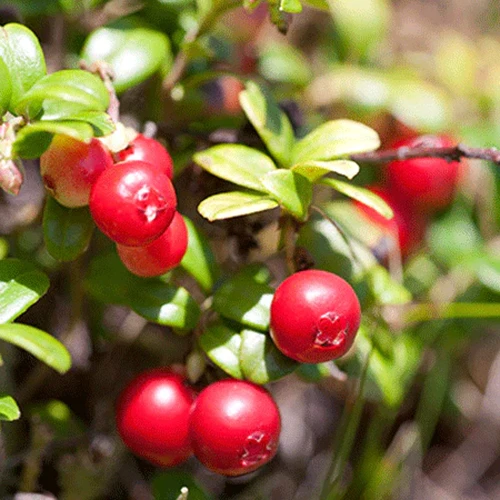While their flavor may be sour, the nutritional value of cranberries is quite sweet!
Fresh berries, dried berries, sauces, and juice all have potential health benefits to offer.
And they’re delicious in a plethora of dishes and preparations.
In fact, you can even grow your own if you have the right climate and type of soil for it.
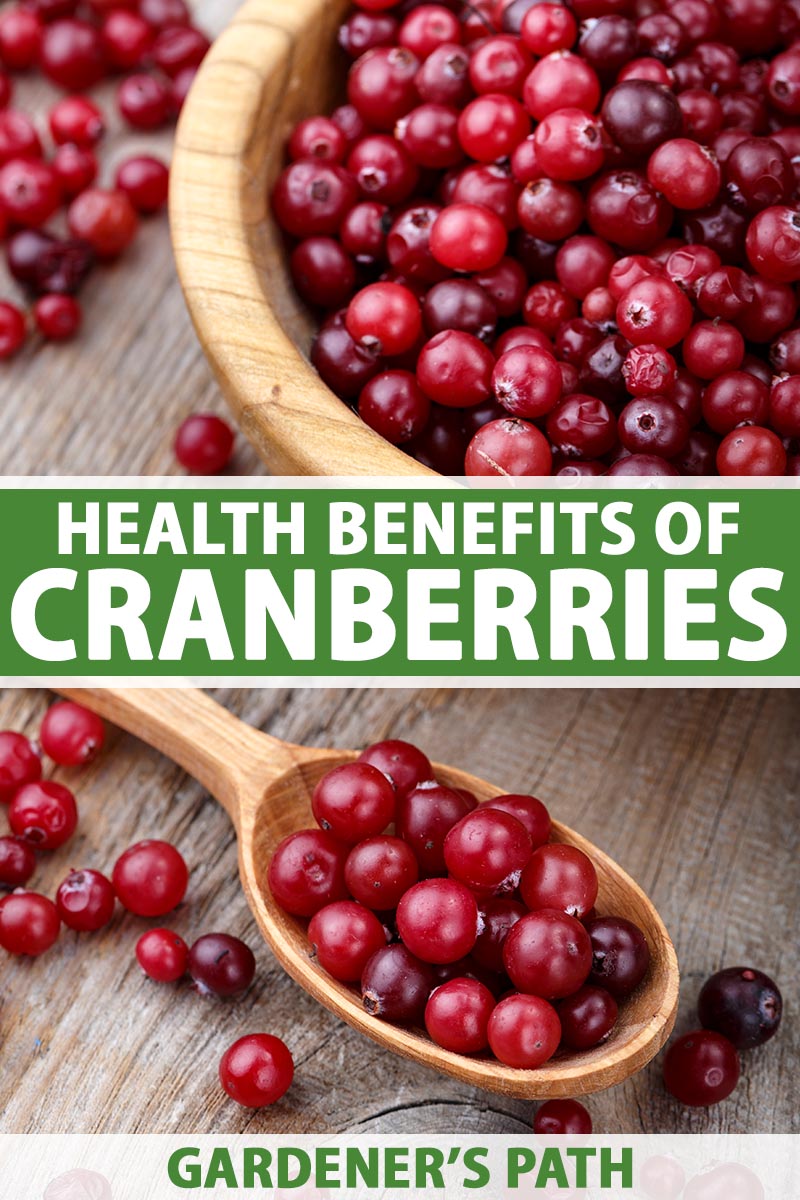
We link to vendors to help you find relevant products. If you buy from one of our links, we may earn a commission.
Here is what we’ll cover in this article:
What You’ll Learn
What Are Cranberries?
Cranberries are the fruits of Vaccinium macrocarpon, or other types of fruit in the Vaccinium genus, though this is the species that is most commonly cultivated in the US.
The shrubs are related to blueberries and huckleberries, and they produce fruit that is more tart.
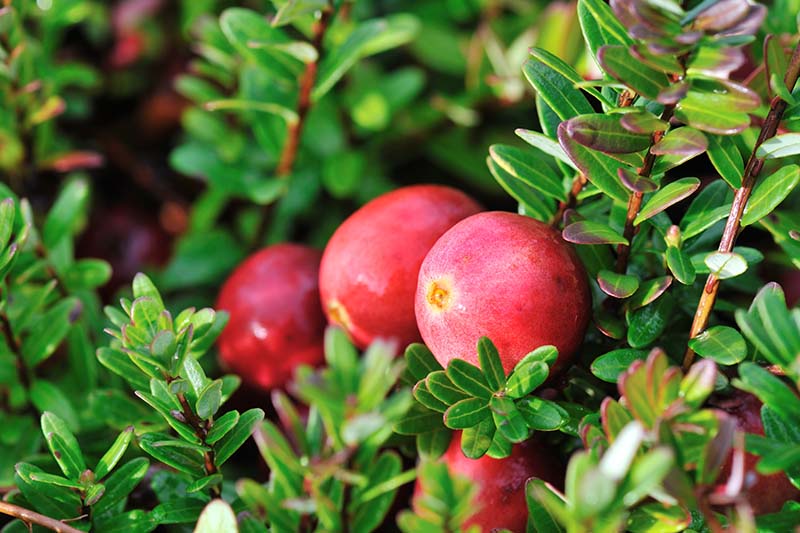
As depicted in the famous Ocean Spray juice commercials, most of the commercially produced cranberries cultivated in Massachusetts and elsewhere are grown in bogs or marshes.
Bogs are flooded at harvest time. The mature berries have internal air pockets, so they float to the top.
They may also be flooded to protect against frost. During the majority of the growing season, however, the bogs remain dry and regular irrigation is used.
This wet harvesting method is used for berries that will be frozen or further processed.
Dry harvesting, or directly picking them off of the shrubs, is another method. This method is used for cranberries that will be sold as fresh fruits, to preserve their shape and texture.
This approach is convenient for growing at home, as I’m sure most people aren’t interested in converting their backyard into a bog!
Before starting, read more about growing your own cranberries.
Vaccinium macrocarpon ‘Stevens’
When you’re ready, you can find ‘Stevens’ cranberry plants in two-quart and two-gallon containers available at Fast Growing Trees.
Or you can check out our roundup of top cultivars.
Nutritional Composition
Once harvested, cranberries may be prepared in a number of different ways and enjoyed fresh, dried, juiced, and in relishes, sauces, pickles and fermentations, baked goods, desserts, and more.
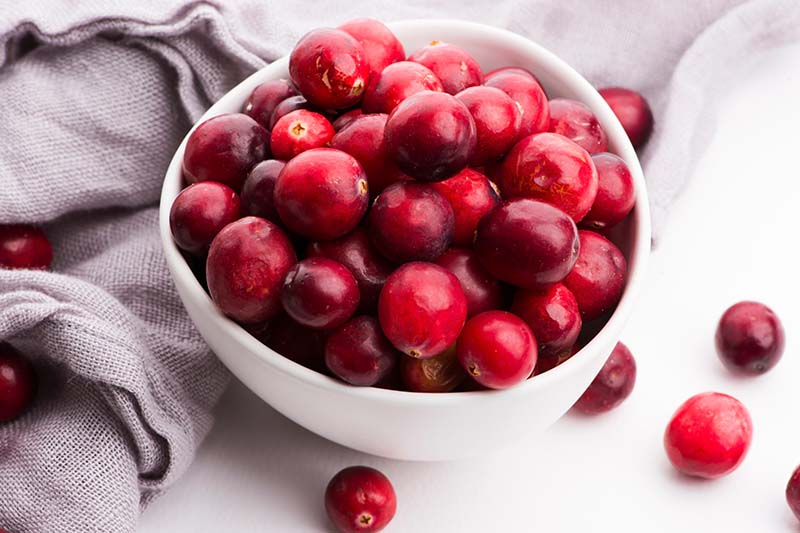
Due to their sharp, tart taste, sugar is often added to make them more palatable.
A bit of sugar will not largely affect the overall nutritional value, but it is something to be aware of when purchasing cranberry products.
Making your own cranberry goods is a great way to control the amount of sugar that’s added. Excess added sugar consumed on a consistent basis can lead to increased risk for certain chronic diseases, such as diabetes or heart disease.
Starting with fresh berries for your recipe preserves much of the nutritional value. A 100-gram serving contains 46 calories, 3.6 grams of fiber, 4.3 grams of sugar, 11 milligrams of phosphorus, and 91 micrograms of lutein and zeaxanthin.
This makes them a low-calorie food with a high nutritional value. Fiber aids in regulating digestion, phosphorus helps to form bone, and lutein and zeaxanthin can help to prevent age-related vision degradation.

Juicing fruits concentrates the quantities of vitamins and minerals that it’s possible to consume in one sitting, but you do lose out on the fiber that you get when eating the whole berry.
A 100-gram serving of 100 percent cranberry juice has 46 calories, 12 grams of sugar, 13 milligrams of phosphorus, 77 milligrams of potassium, 9.3 milligrams of vitamin C, and 5.1 micrograms of vitamin K.
Keep in mind that many cranberry juices are not 100 percent juice, and can contain significant amounts of added sugar or a blend of other juices, which may mean less of these nutrients are available per serving as well.
Compare a few different nutrition facts panels from different products the next time you are shopping, and be sure to read the labels carefully!

Dried berries tend to be higher in calories, as removing the water concentrates the sugars – and some commercially prepared dried fruits have added sugar.
A one-ounce serving with no added sugar has 130 calories, 2 grams of fiber, 27 grams of sugar, and 55 micrograms of lutein and zeaxanthin.
Cranberry sauces vary in nutrition content based on the brand or recipe you are following. Sauces utilizing the whole berry and limiting excess sugar will be the best options in terms of nutrition (and in my opinion these often taste the best as well!).
Potential Health Benefits
As if the vitamins and minerals weren’t enough to convince you to eat more cranberries, there are several potential health benefits that they offer too.
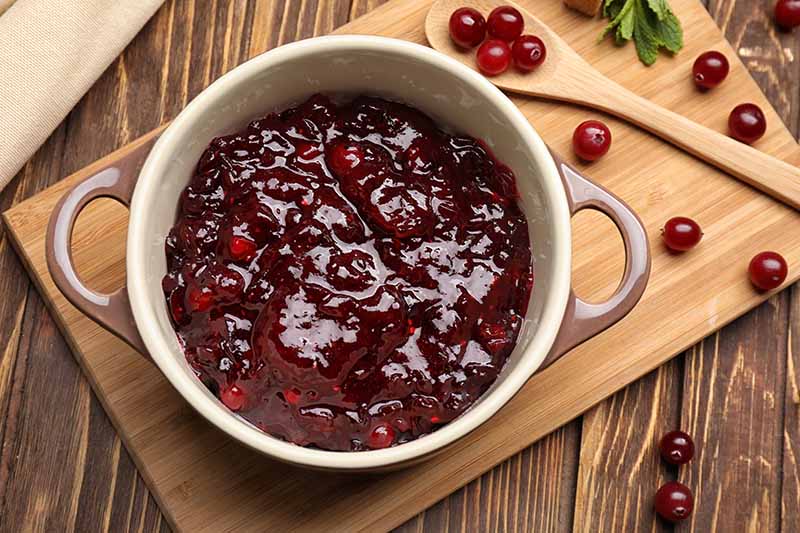
They contain phytochemicals (plant chemicals) called proanthocyanidins, or PACs for short. PACs have unique properties that allow them to block certain types of bacteria from adhering to cell walls.
These PACs are the reason that cranberries are associated with a reduced risk of urinary tract infections. Looking at a review of the research, however, we now understand that cranberries are not as effective at preventing UTIs as was once thought.
This may partially be due to the fact that a high amount of PACs are needed to be truly beneficial, and obtaining that high of an amount by consuming juice may be difficult to accomplish, particularly of a variety with such a tart flavor.
The phytochemicals in cranberries can be beneficial in other ways, however. The berries are full of flavonoids, a class of compounds found in plants that give them their color and act as antioxidants in our bodies.
One of the major types of flavonoid found in these fruits is quercetin, which has been associated with anticancer activity.
While no one food or compound can cure or reverse the disease process, in vitro studies using cultured human tumor cells (i.e. not in the body) show that quercetin can help to inhibit the growth of breast and colon cancer cells.
Flavonoids in general have been shown to reduce the risk of cardiovascular disease, and may possibly lower blood pressure in older populations with hypertension. According to this 2018 review, more research is needed to determine appropriate dosing required to most effectively reap these benefits.
Also present are anthocyanins, another type of flavonoid that has antioxidant properties. These help to prevent damage to cells caused by harmful free radicals. This compound typically gives plants a red or blue hue, hence the vibrancy of these beautiful little berries.
Beneficial Berries
Vitamins, minerals, beneficial compounds – if “cranberry recipes” isn’t currently in your search bar, I don’t know what you’re waiting for!
With the holiday season approaching, check out this pomegranate cranberry sauce from our sister site, Foodal. Or if you’re feeling ambitious and you can provide the right conditions for your plants to thrive, start growing your own!

Just remember that if the biggest profit in terms of nutritional value is what you’re after with these fruits, try to decrease the amount of added sugar that you consume with them as much as possible to maximize your benefits.
Have you ever grown or harvested your own cranberries? What are your favorite ways to enjoy them? Let me know, and leave any tips in the comments below.
To learn more about the benefits that the fruits and vegetables growing in our gardens can offer, read these articles next:
- Health Benefits of Beets
- What Are the Health Benefits of Homegrown Collard Greens?
- Health Benefits of Parsnips
© Ask the Experts, LLC. ALL RIGHTS RESERVED. See our TOS for more details. Product photo via Fast Growing Trees. Uncredited photos: Shutterstock. With additional writing and editing by Allison Sidhu.
The contents of this article have been reviewed and verified by a registered dietitian for informational purposes only. This article should not be construed as personalized or professional medical advice. Gardener’s Path and Ask the Experts, LLC assume no liability for the use or misuse of the material presented above. Always consult with a medical professional before changing your diet, or using supplements or manufactured or natural medications.

